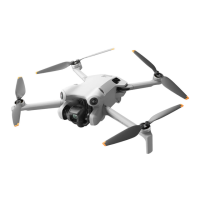DJI Mini 4 Pro
User Manual
108
©
2023 DJI All Rights Reserved.
Max Supported Mobile
Device Size
180×86×10 mm
Operating
Temperature
-10° to 40° C (14° to 104° F)
Charging Temperature 5° to 40° C (41° to 104° F)
Charging Time 2.5 hours
Charging Type It is recommended to use a 5V/2A charger.
Battery Capacity 18.72 Wh (3.6 V, 2600 mAh × 2)
Battery Type 18650 Li-ion
Dimensions 104.22×149.95×45.25 mm
Weight 375 g
Supported Mobile
Device Port Type
Lightning, USB-C, Micro-USB
* Using a mobile device with Micro-USB port requires the DJI RC-N1 RC Cable
(Standard Micro USB connector), which is sold separately.
Video Transmission
Operating Frequency
[6]
2.4000-2.4835 GHz, 5.170-5.250 GHz, 5.725-5.850 GHz
Transmitter Power
(EIRP)
2.4 GHz: <33 dBm (FCC), <20 dBm (CE/SRRC/MIC)
5.1 GHz: <23 dBm (CE)
5.8 GHz: <33 dBm (FCC), <14 dBm (CE), <30 dBm (SRRC)
[1] Standard aircraft weight (including the Intelligent Flight Battery, propellers, and a microSD card). The
actual product weight may vary due to dierences in batch materials and external factors. Registration
is not required in some countries and regions. Always check local laws and regulations before use. With
the Intelligent Flight Battery Plus (sold separately and only in select countries), the aircraft will weigh more
than 249 g. Always check and strictly abide by local laws and regulations before ying.
[2] The max horizontal speed is subject to dynamic local restrictions. Always abide by local laws and
regulations when ying.
[3] Increase in aircraft weight can affect flight propulsion. When the aircraft is using the Intelligent Flight
Battery Plus, do not mount additional payloads like a propeller guard or third-party accessories to avoid
diminished propulsion.
[4] Measured in a controlled test environment. Specific test conditions are as follows: flying forward at a
constant speed of 21.6 kph in a windless laboratory environment at 20 meters above sea level, in photo
mode (without photo taking operation during ight), with Obstacle Avoidance Action set to O, and from
100% battery level until 0%. Results may vary depending on the environment, actual use, and rmware
version.
[5] Measured in a controlled test environment. Specic test conditions are as follows: hovering in a windless
laboratory environment at 20 meters above sea level, in photo mode (without photo taking operation
during ight), with Obstacle Avoidance Action set to O, and from 100% battery charge until 0%. Results
may vary depending on the environment, actual use, and rmware version.
[6] In some countries and regions, the 5.8 and 5.1GHz frequencies are prohibited, or the 5.1GHz frequency is
only allowed for indoor use. Check local laws and regulations for more information.
[7] Measured in an unobstructed outdoor environment free of interference. The above data shows the
farthest communication range for one-way, non-return ights under each standard. Always pay attention
to RTH reminders in the DJI Fly app during your ight.
[8] Data tested under FCC standard in unobstructed environments with typical interference. Used for
reference purposes only and provides no guarantee for actual transmission distance.
[9] Data tested under FCC standard in obstructed environments with typical low interference. Used for
reference purposes only and provides no guarantee for actual transmission distance.
[10] Depending on the actual environment and mobile device.

